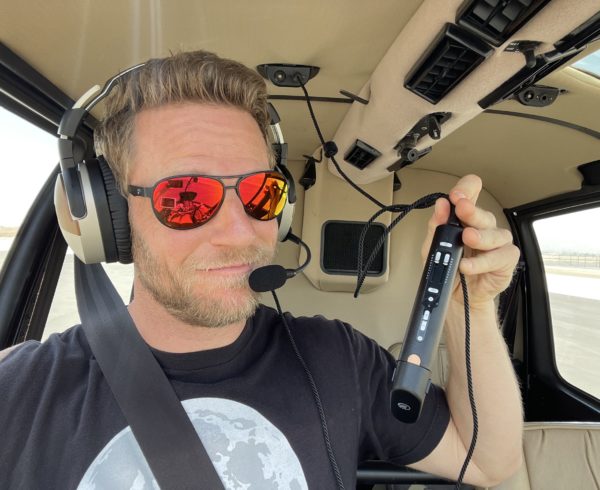Randy Powell knows carbon monoxide (CO). During a long career working with heating and air conditioning systems, he’s very much aware of CO emissions. In the course of his work, he’s had mild CO poisoning a time or two, and he knows the signs. He was also the guy the local fire department would call to test and track down sources of CO in a home. He sometimes had to deliver the bad news that a home was unsafe to occupy until a CO problem was remedied.
Powell is also a longtime pilot, and he felt pretty confident that he would recognize a CO problem in an aircraft. So confident that he was a bit skeptical this year at AirVenture, when Louis Hindman, Lightspeed’s Director of Product Development and Quality, asked him if he would beta test the new Lightspeed Delta Zulu ANR headset, with its built-in CO monitor and HearingEQity features. Powell loves his Lightspeed PFX headset and doubted that a built-in CO monitor would have a lot of benefit for him. But Louis wasn’t dissuaded. He said, “When you give us feedback, I know I’ll get an honest answer.” So, Powell reluctantly agreed to test a prototype Lightspeed Delta Zulu.
Once the Lightspeed Delta Zulu app was installed on his phone, Powell used it to adjust the headset to his hearing. To his surprise, the app showed some hearing deficiencies. (He jokes, “My wife has told me that for years.”) The next morning, he headed home from Oshkosh to Virginia, with his friend Al McMath in the pilot seat. He found that, with the adjustments for his hearing, the Lightspeed Delta Zulu performed well and delivered great sound quality, as he had come to expect from a Lightspeed headset.
What he didn’t expect was that 45 minutes into the flight, he developed a headache, then nausea, and then he felt sleepy. He’d noticed a slight exhaust smell early on, but McMath was fine, and Powell was just the passenger on this flight, so a nap seemed like a pretty good idea. He was drifting to sleep when the CO “caution” alarm went off in the Lightspeed Delta Zulu headset at 50 ppm. By the time Powell got to opening the app (he was running ForeFlight at the time, and the Lightspeed App was not open) and looked at the reading on his phone, he saw a CO reading of 120 ppm. (According to OSHA, the safe level for 8-hour exposure is no more than 50 ppm; over 101 ppm is considered dangerous if anyone present is experiencing symptoms.) Within minutes, the “critical” CO level alarm went off in the headset. Powell and McMath quickly opened the vents and windows to ventilate the cabin and, sure enough, the reading went down. They used the headset and app to monitor CO levels for the rest of the trip and made it home safely. It took a couple days before Powell felt 100% better.
Since the trip, McMath has ordered new door seals and exhaust stacks for his plane. He’s always preferred the look of short exhaust stacks, but he thinks they allowed exhaust to come in the passenger door because of the way the prop blast swirls around the fuselage. Powell was likely affected first because of those passenger-side emissions, the fact that he’s a smoker (which increases susceptibility to CO), and the fact that McMath was a bit warm in the cabin and so had a fresh air vent blowing in his face.
Powell says he can’t help wondering what would have happened if he had been flying alone. “I’ve literally had to remove people from their homes because there was carbon monoxide present, but I didn’t recognize the signs. By the time the symptoms are overwhelming, you’re already not thinking clearly. I felt bad, so I thought I’d just relax and take a little nap. Had I been flying by myself, that headset could literally have made the difference between life and death.”
Even if Powell had suspected the problem, the CO detector card on the dashboard would have misled him. “It never changed color. But the Lightspeed Delta Zulu alarm worked surprisingly, amazingly well.” He adds with a grin, “It was almost like having my wife yelling at me.” But he turns serious again and says the experience changed his mind about the value of a built-in CO monitor, “People need to understand that CO can happen in any aircraft, any time. The plane I was in is extremely well-maintained. CO is so insidious; it sneaks up on you and you don’t realize before it’s too late. I think there’s every potential for this new headset to save more lives.”















Great article on the most silent danger in the sky. I appreciate reading this story and like most of us, eye opened by learning from other’s experiences.
It’s very scary to know something so silent can take us out!
Most pilot students don’t really understand the risk, maybe because they don’t know anyone who’s been affected by it yet.
Awesome post! Time to inform more people!!
I love hearing real life stories of CO poisoning and the dangers associated with it. To be honest, it never really hit me until one of my good friends (who was also my flight instructor) had a run in with CO while helping someone with a refresher flight. The guy who he was with was about to take his family on a long cross country a few days later. It is so scary to think what would have happened had he not decided to fly with an instructor prior to his flight with his family. Since then I’ve always flown with a good CO detector!
Being a low-time pilot still, I often wonder whether I’ll be ready to face a emergency situation, despite training. Because until someone truly has an emergency, you just really don’t know how they will actually respond.. We certainly *hope* we’ll react according to our training thought.
Reading Randy’s story reminded me of this. Despite his training with CO, it still crept up on him as if he hadn’t. Lightspeed’s is on a mission to help close the gap on situations we might think we have awareness of or think “that’ll never happen to me.” I appreciate Randy not only sharing his story, but doing it with a little sense of humor, amidst a serious situation.
Thank you for sharing Randy’s story. The card CO detectors don’t seem to give any warning. I read the back of one that indicated it would take over two hours at over 70ppm before it would change color. For years I used an electronic CO detector that gave an instantaneous reading. But it would malfunction after 2-3 years. I happily replaced it four times just to have the information & “protection.” I am looking forward to a new Delta Zulu for my next CO detector!